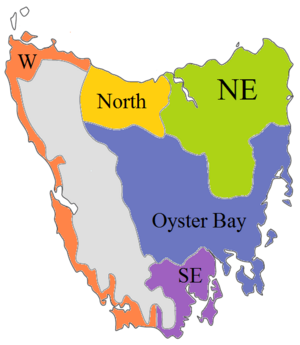Eastern Tasmanian languages
Topic: Social
 From HandWiki - Reading time: 4 min
From HandWiki - Reading time: 4 min
| Eastern Tasmanian | |
|---|---|
| Oyster Bay – Bruny | |
| Ethnicity | Oyster Bay, Big River, and Bruny tribes of Tasmanians |
| Geographic distribution | Eastern coast of Tasmania and interior |
| Linguistic classification | Possibly one of the world's primary language families (see Tasmanian languages) |
| Subdivisions |
|
| Glottolog | None oyst1235 (Oyster Bay)[1] sout1293 (Bruny/Southeast)[2] |
 Eastern Tasmanian language families per Bowern (2012)
Oyster Bay
Southeast Tasmanian | |
Eastern Tasmanian is an aboriginal language family of Tasmania in the reconstruction of Claire Bowern.[3]
Languages
Bayesian phylogenetic analysis suggests that four (at p < 0.20) to five (at p < 0.15) Eastern Tasmanian languages are recorded in the 26 unmixed Tasmanian word lists (out of 35 lists known). These cannot be shown to be related to other Tasmanian languages based on existing evidence. The languages are:[4]
- Eastern Tasmanian
- Oyster Bay (Central–Eastern Tasmanian) (2)
- Oyster Bay (Oyster Bay and Big River tribes)
- Little Swanport
- Bruny (Southeastern Tasmanian) (2–3, Bruny tribe)
- Southeast Tasmanian
- Bruny Island
- Oyster Bay (Central–Eastern Tasmanian) (2)
Two of the lists reported to be from Oyster Bay contain substantial Northeastern admixture (see Northeastern Tasmanian languages), which Bowern believes to be responsible for several classifications linking the languages of the east coast. However, once that admixture is accounted for, the apparent links disappear.[3]
Descendants
The Flinders Island lingua franca was based primarily on Eastern and Northeastern Tasmanian languages.[5] The English-based Bass Strait Pidgin continued some vocabulary from the lingua franca.[6] The constructed language Palawa kani is based on many of the same languages as the lingua franca.[7]
References
- ↑ Hammarström, Harald; Forkel, Robert; Haspelmath, Martin, eds (2017). "Oyster Bay-Big River-Little Swanport". Glottolog 3.0. Jena, Germany: Max Planck Institute for the Science of Human History. http://glottolog.org/resource/languoid/id/oyst1235.
- ↑ Hammarström, Harald; Forkel, Robert; Haspelmath, Martin, eds (2017). "South-Eastern Tasmanian". Glottolog 3.0. Jena, Germany: Max Planck Institute for the Science of Human History. http://glottolog.org/resource/languoid/id/sout1293.
- ↑ 3.0 3.1 Claire Bowern, September 2012, "The riddle of Tasmanian languages", Proc. R. Soc. B, 279, 4590–4595, doi:10.1098/rspb.2012.1842
- ↑ Bowern (2012), supplement.
- ↑ NJB Plomley, 1976b. Friendly mission: the Tasmanian journals of George Augustus Robinson 1829–34. Kingsgrove. pp. xiv–xv.
- ↑ Rob Amery & Peter Mühlhäusler (2011) 'Pidgin English in New South Wales', in Wurm, Mühlhäusler, & Tryon (eds.), Atlas of Languages of Intercultural Communication in the Pacific, Asia, and the Americas
- ↑ Berk, Christopher D. (2017). "Palawa Kani and the Value of Language in Aboriginal Tasmania". Oceania 87: 2–20. doi:10.1002/ocea.5148.
 |
 KSF
KSF